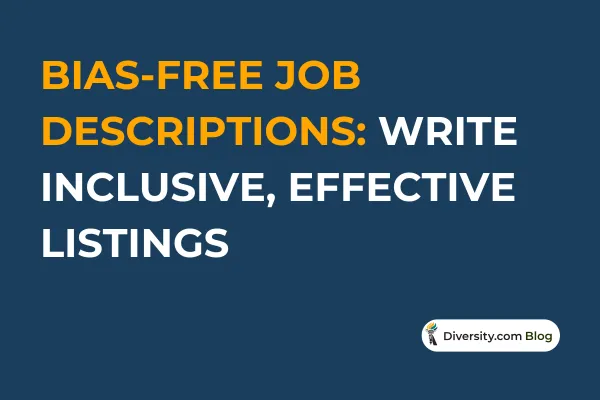
Bias-Free Job Descriptions: Write Inclusive, Effective Listings
Job descriptions are often the first point of contact between a candidate and a company.
But subtle choices in language, tone, or structure can unintentionally signal bias, discouraging people from applying, even if they’re qualified.
Inclusive job descriptions create a more equitable hiring process.
They help organizations reach broader talent pools and ensure that great candidates don’t self-select out before they ever speak to a recruiter (LinkedIn Talent Solutions, 2023).
What Makes Job Descriptions Biased?
Bias in job descriptions doesn’t always come from malice. More often, it’s a byproduct of habits: recycled templates, internal jargon, or assumptions about what a “good fit” looks like.
Common sources of bias include:
Gender-coded language (e.g., “rockstar,” “dominant,” “nurturing”)
Requirements that aren’t truly essential
References to physical ability when not job-relevant
Cultural references or idioms that may alienate global talent
Unclear or inflated experience levels
Each of these can subtly limit who feels welcome to apply (Williams & Mihaylo, 2022).
Words and Phrases That Signal Exclusion
Certain words carry associations—whether intended or not. Textio’s analysis of over 100 million job posts shows that gender-coded terms significantly shift who applies (Textio, 2023).
Examples to reconsider:
“Aggressive” or “competitive” → Try “goal-oriented” or “motivated”
“Strong English skills” → Try “effective written and verbal communication”
“Must be able to lift 25 lbs” → Only include if truly necessary
“Digital native” → Can imply age bias
Language that’s too rigid or culturally narrow makes your team look less welcoming—even when your intent is neutral.
How to Audit Your Existing Job Descriptions
Auditing doesn’t require a complete rewrite. Start with a few key steps:
Highlight any jargon or internal phrases.
Look for unnecessary qualifications or inflated requirements.
Review tone: is it overly aggressive or oddly casual?
Check for language that assumes cultural norms or physical ability.
Use bias-checking tools like Textio, Datapeople, or Gender Decoder.
Even small changes—like using “you will” instead of “the ideal candidate must”—can shift the tone toward openness (LinkedIn Talent Solutions, 2023).
Inclusive Language Guidelines to Follow
Use plain language. Keep descriptions readable and avoid unnecessary complexity.
Focus on what’s needed to succeed. Avoid laundry lists of “nice-to-haves.”
Highlight support and flexibility. Mention benefits like remote work, parental leave, or accessibility.
Be transparent. Include salary ranges and outline the hiring process when possible (Buffer, 2024).
Name your values. Candidates want to know if your workplace respects inclusion, not just claims it.
Real-World Examples of Inclusive Job Descriptions
Some companies are setting strong examples:
Atlassian found that inclusive job descriptions improved the gender balance of applicants and reduced dropout in later stages (Atlassian, n.d.).
Buffer makes transparency part of its hiring culture by publishing salaries and career paths (Buffer, 2024).
Textio customers have seen stronger engagement across underrepresented groups just by adjusting language tone and framing (Textio, 2023).
Tools to Help You Write Better Job Ads
Textio: Analyzes job posts for gender bias and tone
Datapeople: Offers structured templates and real-time language suggestions
Gender Decoder: Free tool that checks for gender-coded language
Joblint: Flags problematic phrases or unclear expectations
Final Thoughts: Bias-Free Language as a Hiring Advantage
Writing bias-free job descriptions signals fairness, trust, and clarity to candidates.
It helps reduce barriers for people who are often overlooked, creating space for better hiring and better teams.
How Diversity.com Supports Inclusive Hiring
At Diversity.com, we know that inclusive hiring isn’t about lowering standards—it’s about raising the bar and removing outdated filters that limit potential.
That’s why we equip employers with the tools, strategies, and talent pipelines to build teams that are qualified, diverse, and forward-thinking—without compromising on excellence.
Whether you're refining your recruitment process, improving retention, or navigating new DEI challenges, we’re here to support your mission with real solutions and real results.
For Employers & HR Professionals:
✔ Create a free employer account — Start posting jobs that reflect your values. Choose from single listings, job packs (discounted credit bundles), or subscription plans tailored to your hiring needs.
✔ Access a diverse, top-tier candidates — Connect with professionals who bring both qualifications and fresh perspectives to your team.
✔ Stay informed with expert DEI insights — Learn how to apply inclusive strategies without sacrificing performance.
For Job Seekers:
✔ Explore inclusive career opportunities — Discover employers that care about merit, culture, and impact.
✔ Create a free job seeker account — Apply confidently for jobs with companies that believe in equity.
✔ Understand Inclusive Hiring — Learn how DEI really works—and how it can work for you.
We don’t lower standards. We eliminate the barriers that keep talent hidden.
Start building a better, bolder team today—with Diversity.com.
Questions? Contact Us, and we'll walk you through it.
Related Articles
What Is Employee Belonging? Build a Culture That Includes Everyone
Workplace Representation Strategy: A Guide for Inclusive Talent Teams
Unconscious Bias Training for Recruiters: What Works and Why
Merit-Based Hiring Practices: Balancing Fairness and Representation
Sources & References
Atlassian. (n.d.). How inclusive language improved our applicant diversity. https://www.atlassian.com/blog/inside-atlassian/inclusive-language-job-descriptions
Buffer. (2024). Our transparent salary formula. https://buffer.com/salary
LinkedIn Talent Solutions. (2023). The language of job descriptions: A guide to gender neutrality. https://business.linkedin.com/talent-solutions/resources
Textio. (2023). What we’ve learned from analyzing 100M+ job descriptions. https://textio.com
Williams, M., & Mihaylo, T. (2022). Bias in recruitment and how language shapes inclusion. Journal of Workplace Diversity, 18(3), 211–223.

